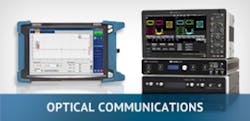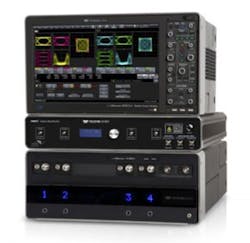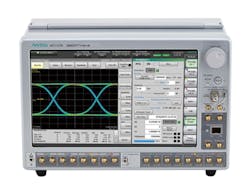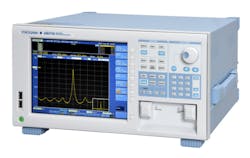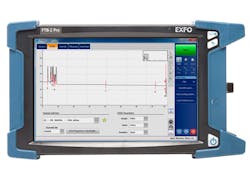Shining a light on bandwidth, data-transmission measurements
Ever increasing data-transmission speeds coupled with the need to contend with higher-order modulation schemes are presenting optical-communications test-and-measurement challenges. Products ranging from complete optical modulation analysis systems to software tailored to optical-communications formats can help propel optical communications capabilities toward 130 Gbaud.
“The optical communication industry is always on the lookout for ways to increase the data-transmission speed,” said Dr. SungHoon Im, director of technical sales at Coherent Solutions. “Nonconventional technologies such as coherent modulation formats, OFDM, and few-mode transmission are driving the need for truly flexible test equipment that can handle these new technologies.”
To meet the challenges, Im said, “Our IQTransmitter provides our customers with the highest bandwidth and the most advanced automatic bias control to enable reliable generation of high-quality coherent optical signals.” He added, “IQTransmitter is the only product on the market with 40 GHz of analog bandwidth and is the obvious choice for customers working on next-generation transmission speeds, such as 56 Gbaud.” He said that the company pairs its hardware products with intuitive software controllers so that customers can easily utilize the numerous hardware features.
Other products include optical coherent transmitters, an IQ modulator automatic bias controller, a narrow linewidth tunable laser, a variable optical attenuator, an optical switch, and a power meter. Also, Im said, Coherent serves as an ODM supplier to its partner company Teledyne LeCroy for optical modulation analyzers (OMAs).
Patrick Connally, technical marketing engineer for high-bandwidth oscilloscopes at Teledyne LeCroy, elaborated on the OMAs (Figure 1), saying they leverage the seamless integration between Teledyne LeCroy’s 10Zi-A Series real-time oscilloscopes and Optical-LinQ analysis software. He said the oscilloscope and software in tandem with the IQS42 and IQS70 Coherent Optical Receivers test DP-QSPK, DP-16QAM, and other formats of optical signals.
Courtesy of Teledyne LeCroy
He said the IQS70 Coherent Optical Receiver together with the 10-65Zi-A oscilloscope provide a system bandwidth of 65 GHz and can characterize leading-edge 56-Gbaud communications systems and enable detection at up to 130 Gbaud. For lower-rate applications, the 42-GHz IQS42 Coherent Optical Receiver pairs with the 36-GHz 10-36Zi-A to test signals up to 32-Gbaud DP-16QAM or DP-QSPK.
Connally concurred with Im that “… the optical communications industry continuously seeks ways to increase data-transmission speed. New technologies such as coherent modulation formats, OFDM, and few-mode transmissions are driving the need for truly flexible test equipment which can handle these new technologies. Our IQS OMA system with its modular architecture and integrated software provides a uniquely flexible platform best suited to handle any nonconventional techniques that customers may be developing.”
Key trends
Mike Kelly, Ph.D., application developer, and Robert Jahn, product marketing manager, both at Keysight Technologies, compiled a list of trends driving the need for innovation in optical communications test:
- ROADM-based networks drive a dramatic increase in measurement content for calibrating components, requiring higher test repetition rates and wavelength accuracy. Complex modulated signals drive more advanced polarization-dependent measurements. And the increasing integration level of components requires synthesis of traditional passive optical test methods with electrical and RF measurements.
- Higher speed classes on long-distance lines (100G/400G/1Tb) drive the need for coherent detection of modulation schemes. Test equipment must be able to characterize the signal and the robustness of receiver detection algorithms.
- Higher speed datacom transceivers have a need for deeper characterization of built-in components like WDM filters.
Keysight, they said, offers a complete stimulus response solution with optical modulation analyzer and high-speed arbitrary waveform generators and a broad range of characterization tools with tunable laser sources, power meters, and solution software to support the time-consuming characterization work.
Insatiable demand for bandwidth
“In general, the insatiable demand for data bandwidth in communication systems requires higher bit rates, more bits per unit interval, or both,” said David Taylor, technical marketing manager, Tektronix. He said Tektronix is uniquely positioned to deliver the measurement capabilities needed to enable communication engineers to continue to advance the state of the art with respect to both direct signal modulation and higher-order modulation.
“Emerging higher levels of direct signal modulation are impossible to analyze with conventional NRZ measurement tools,” he said. “Tek’s portfolio has the highest sensitivity, which translates to the best possible margin in performing these sensitive measurements.”
In addition, he said, “Higher-order modulation requires close attention to instrument-induced vertical noise and jitter noise floors. The combination of the capability to perform advanced equalization and clock extraction from the most heavily marginalized signal is unique to Tek’s Real-Time PAM-4 solution.”
He added, “Tektronix’ optical PAM-4 portfolio leverages the industry’s most sensitive/lowest noise optical modules (80C15/80C10). Tek’s real-time ATI oscilloscope portfolio (DPO70000SX) has the lowest noise and highest ENOB in the industry, which are critical for PAM-4 measurements.”
From development to installation
Hiroshi Goto, business development manager at Anritsu, said, “Anritsu offers a full portfolio of solutions that can be used during development, manufacturing, and installation and maintenance of optical devices, modules, and systems.” For example, the new BERTWave MP2100B (Figure 2) supports simultaneous BER measurements and eye-pattern analysis. “By combining the measurement capability of two instruments, the BERTWave MP2100B reduces cost-of-test by as much as 40% and significantly improves test times and measurement reliability,” Goto said. “Its built-in bit error rate tester (BERT) can be configured to one, two, or four channels to reduce the time to conduct simultaneous BER measurements of multichannel optical modules by as much as 80%.” He added that a new fast sampling mode with speeds up to 150 kS/s permits eye pattern analyses—such as eye mask tests—to be performed up to 1.5 times faster than with legacy models.
Courtesy of Anritsu
Anritsu also has recently introduced an integrated test solution featuring its MP1800A BERT signal quality analyzer and GRL-PCIE4-BASE-RXA calibration/receiver test software from Granite River Labs (GRL) that simplifies calibration so engineers can conduct high-quality reproducible receiver and jitter tolerance tests on high-speed devices, Goto said. The new solution also incorporates a noise signal source, a variable ISI channel, and a real-time oscilloscope. The GRL software controls the system to automate calibration of the complex test signal and simplifies jitter tolerance tests for verification of high-speed designs.
OFC exhibits
At OFC March 20-24 in Anaheim, CA, Anritsu will for the first time exhibit the BERTWave MP2100B, Goto said. Also, the company will show the MP1800A in a variety of configurations, including one with the Anritsu 4PAM/8PAM converter (MZ1834A/MZ1838A). This system can generate the high-quality, low S/N, 4PAM and 8PAM data signals required for the characterization of high-speed backplanes and 400 GbE interfaces. In another configuration, four MP1800A BERTS will be synchronized to create an ultra-high-speed transmission test system that supports testing up to 1 Tb/s with multichannel synchronization signals, such as Quad DP-16QAM and Dual DP-64QAM.
Im at Coherent said his company will exhibit a high-bandwidth coherent communications test platform, which consists of the 40-GHz IQTransmitter with auto bias control, the IQS70 Coherent Optical Receiver with 70 GHz of bandwidth, a 65-GHz Teledyne LeCroy real-time oscilloscope, and a high-speed electrical signal source from another partner company. “This setup will have enough bandwidth to generate and characterize next-generation baud rates such as 56 Gbaud and higher,” he said. “We also will be launching our new IQABC, the IQ modulator automatic bias controller. IQABC uses sophisticated algorithms to accurately track and stabilize the bias points of any OIF-compliant IQ modulator. It will ensure that the coherent optical signal our customers generate always will be stable and repeatable to save them equipment setup time and enable them to accelerate their product development and testing.”
In addition to featuring its optical modulation analysis platforms, Teledyne LeCroy will highlight its VectorLinQ Vector Signal Analysis software, which enables users to gain a means of looking at the electrical tributaries of their higher-order modulation signals. “Unlike some competing offerings based on VSA packages for RF communications, we designed VectorLinQ from the ground up to run on oscilloscopes for optical applications,” Connally said.
“The software’s unique user interface enables you to build signal-processing chains with elements such as filters, mixers, phase estimators, and equalizers,” he said. “Even more flexibility comes through the ability to insert custom MATLAB processing blocks at any point in the processing chain. The I and Q signals are passed to MATLAB, the custom code is applied to them, and the results are returned to VectorLinQ to be handed off to the next processing block, visualized, and measured. The software offers various ways to analyze and view demodulated waveforms, such as constellation and eye diagrams, as well as myriad parameter measurements. Its unique multistream architecture lets users view up to eight demodulated signals at once; these can be eight separate signals from the same oscilloscope or the same signal with eight different processing chains applied to it for comparison of results. This results in an excellent tool for prototyping DSP algorithms.”
Tektronix will highlight several products at OFC, Taylor said:
Courtesy of Tektronix
In addition, he said, “For multilane generation, the PatternPro PPG Series pattern generators and PED series error detectors provide test generation and BER of PRBS and custom patterns for 100G and 400G NRZ and PAM-4 applications in multichannel test configurations.”
Keysight Technologies plans to highlight several products at OFC, including the N4391A and N4392A optical modulation analyzers, the 81606A tunable laser sources, the M8195A arbitrary waveform generator, N7700A Photonic Application Suite software, 81195A Optical Modulation Generator software, and the Lightwave Component Analyzer.
“Our products emphasize traceable and well-defined specifications for optimum accuracy under application conditions, whether measuring power, wavelength, polarization, RF responsivity, or digital modulated signals,” Kelly and Jahn noted. “The combination of fiber-optic technology, high-speed digital and RF capabilities, and application software allows Keysight to meet the new challenges in optical communications test.”
They added that Keysight offers complete test solutions (including optical modulation analyzers, BERTs, and arbitrary waveform generators) to cover the test needs of next-generation optical networks in the telecom and datacom area with speeds up to 400G/1T.
Courtesy of Yokogawa
As this article goes to press, other companies have not detailed their plans for OFC, but they are likely to highlight recently introduced products, including the new Yokogawa AQ6375B optical spectrum analyzer (Figure 4), which operates in the short-wavelength infrared region, covering wavelengths from 1,200 nm to 2,400 nm. With a design based on the company’s AQ6375 instrument, the new analyzer combines high measurement performance with ease of operation, and it incorporates a gas purging feature, a built-in cutoff filter, data-logging capabilities, a double-speed mode, and support for Windows file sharing in addition to the existing Ethernet/GPIB and USB interfaces. The file-sharing feature uses Windows Explorer to access the user area of internal memory via the Ethernet interface using the Windows Server Message Block function.
Applications for the AQ6375B cover the analysis of telecom devices and systems operating in single-mode transmission in all the windows of optical communications from the beginning of the O-band at 1,260 nm to the end of the U-band at 1,675 nm.
In addition, in December EXFO announced the release of its FTBx-740C-DWC high-resolution tunable OTDR (Figure 5), designed to test through-field mux/demux channels using the customer’s wavelength to efficiently troubleshoot faulty links or deliver first-time-right deployments during construction. This DWDM OTDR complements EXFO’s coarse wavelength-division multiplexing (CWDM) OTDR and Ethernet test modules to provide a comprehensive kit for field technicians.
Courtesy of EXFO
With commercial services in fiber-to-the building/fiber-to-the-premises and with cellular backhaul deployments evolving and migrating from CWDM to DWDM, EXFO’s tunable DWDM OTDR empowers technicians to perform in-service tests from the head-end up to the customer’s premises while locating problems and preventing costly SLA penalties and maintenance-downtime periods. In contrast with the traditional light source and OSA approach that requires two technicians and synchronization, this single-ended OTDR test solution enables one technician to quickly respond to network failures. In addition, this technology complements the existing test procedures currently used for CWDM deployments.
EXFO’s FTBx-740C-DWC unit is a tunable OTDR in the C-band and covers channel spacing of 100 GHz/50 GHz based on the ITU-T standard grid. The tunable laser also features a high dynamic range for improved performance and the long reach needed to cover metro/long-haul applications.
Challenging existing networks
The need for high-speed networks will continue to grow. As Kelly and Jahn at Keysight put it, “The needs of big data usage, cloud applications, the Internet of Things, and a huge number of mobile devices are challenging the existing communication networks for wireline and wireless voice and data traffic. The industry has adopted coherent optical transmission communication systems, which use advanced modulation schemes, to cope with the explosive demand for data transportation. This solution comes with some new requirements that need to be understood along the whole communication link from the transmitter through fiber cable and network elements to the receiver.” Capable test equipment will be needed to ensure the network design is robust against signal distortions and link impairments.
And, of course, the equipment will need to be easy to use. As Taylor at Tektronix noted, his company “… offers turnkey test-automation packages that conduct all relevant optical characterization measurements and deliver reports to the end user, who may not be an IEEE standards expert, obviating the need to read and correctly apply thousands of pages of technical procedures to do their job.”
For more information
